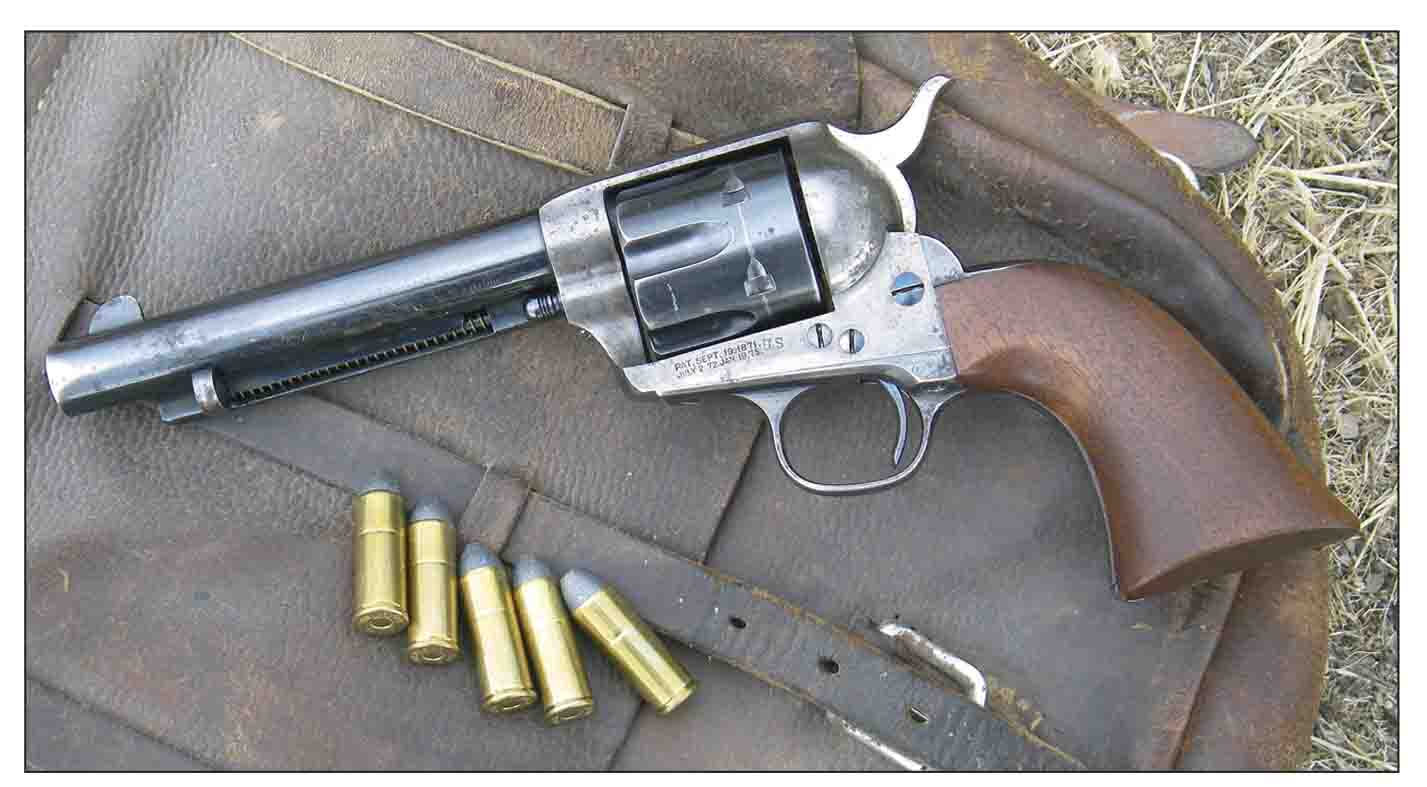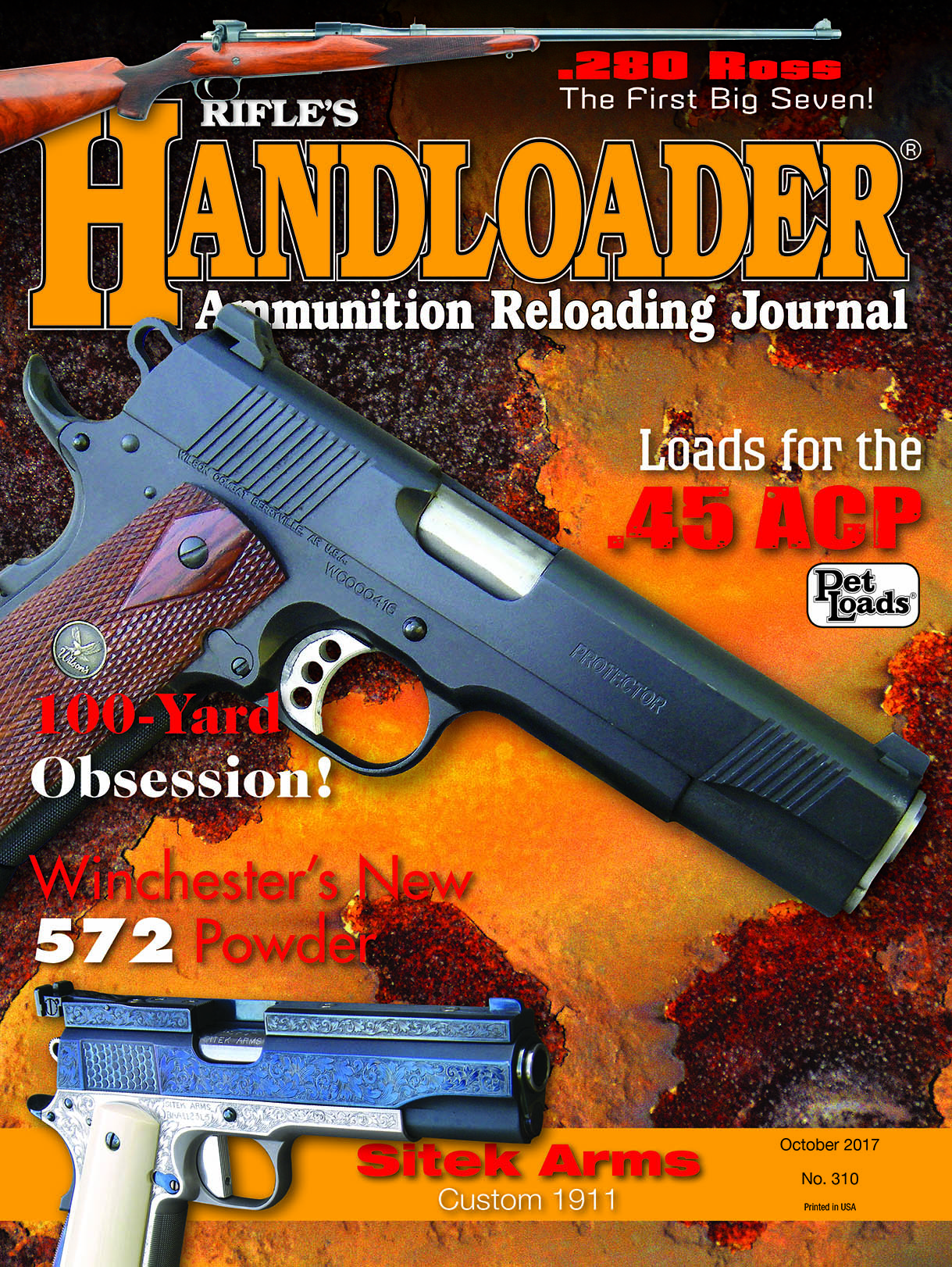Reloader's Press
.45 Colt Myths
column By: Dave Scovill | October, 17

Research suggests one of the myths seemed to originate with Hatcher’s Textbook of Pistols and Revolvers in 1935 and to some degree J.R. Mattern in Handloading Ammunition in 1926. Both writers hedged around the edges regarding dates of manufacture, etc., but Hatcher stated, “. . . the cartridge was originally loaded with 40-grains of black powder.” Mattern said nothing of the sort but did describe the original Frankford Arsenal load (circa 1873-74) with a 250-grain bullet seated over 30 grains of black powder. The question remained: If there was indeed an “original” load with 40 grains of black powder, when and by whom was it introduced?
I started with my neighbor Val Christmann’s extensive collection of gun books, textbooks and catalogs. I purloined a variety of catalogs from Remington, Winchester, DWM, Dominion, etc., in search of the “original” .45 Colt load. Only one, the Remington-UMC 1910 catalog, mentioned 40 grains of black powder with a 250-grain bullet.
Daniel Shuey’s, W.R.A. Co. Headstamped Cartridges and Their Variations first volume (1999) covers cartridges up to .38 caliber; the second volume (2003) continues up to the .50s. In the second volume, the section on the .45 Colt doesn’t mention 40 grains of black powder, but it does chronicle WRA loads with a 260-grain bullet seated over 30 grains of black in 1877, and 35 grains of black in 1882 and 38 grains in 1898, both with a 255-grain bullet.
I also ordered a copy of C. Kenneth Moore’s book, Colt Single Action Army Revolver Study: New Discoveries (2003), in which the author cites correspondence among the U.S. Army, Frankford Arsenal and Colt regarding development and testing of the new .45 Colt load, none of which mentions 40 grains of powder.
Val also introduced me to our new neighbor Pete deCoux, who along with his wife, Gaye, are among the world’s foremost authorities on cartridges, with an extensive collection of both military and domestic samples. Pete is also on the board of the International Ammunition Association (IAA) and mentioned a website with ammunition catalogs, namely UMC, which merged with Remington in 1912 or so, albeit Pete noted the merger took several years to complete, which helps explain the three different headstamps: UMC, Rem-UMC and Remington. At the time, the above-mentioned Remington load in its 1910 catalog was the earliest listing I could find for a 40-grain charge, which also listed 35- and 30-grain black-powder loads, and another listing for the .45 S&W with a 250-grain bullet over 28 grains of black. Noted authority Mike Venturino also mentioned the Remington 1878 catalog did not list the .45 Colt.
Looking over a printout of the UMC catalogs, there it was in 1880 – a 250-grain bullet seated over 40 grains of black powder in a 1.25-inch case. The same load was listed until 1914, 34 years, which also threw a rock at the assumption that the 40-grain charge was discontinued because it was too strong for the Colt SAA.
Pete also allowed me to sift through an inventory of older revolver and rifle cartridges, whereupon I ended up with a couple dozen .45 Colt samples, most of which did not have a cannelure at the base of the bullet, indicating black-powder loads.
Following the discovery of the UMC catalogs, and rummaging through Pete’s collection of “extras,” there was still some concern that something had been missed in the historical record created by various authors, which led to another review of Mattern, Hatcher, Skelton, Roper, Keith, etc. The only writer, it seems, who actually used the Remington 40-grain loads was Elmer Keith, who coincidentally, does not appear to have used the word “original” or a date of origin in Sixguns by Keith, Hell, I Was There! or his “Gun Notes” columns in G&A.
Prior to most of the above, in the summer of 2009, Roberta and I attended a “Shootist” get together, basically a collection of folks in the industry and gun press, in Buena Vista, Colorado. While I was busy admiring a Colt New Service Target .45 Colt, Roberta wandered off to watch folks on the firing line, one of whom was Charlie Hanna shooting his Colt SAA .41 Colt. Mr. Hanna is a retired Kansas state trooper with an avid interest in western history, which naturally included all sorts of firearms and cartridges. While I watched, Charlie and Roberta struck up a conversation, and within minutes, she was shooting his Colt.
Since then, Charlie and I have corresponded, owing our common interest in Colts and handguns in general, and he has shared his research into a long list of handguns and cartridges reportedly used by some famous and not-so-famous lawmen and desperados. Some of the records come from newspapers but are largely from excerpts by various authors, a few of which include comments regarding the infamous .45 Colt with the 40-grain charge of black powder.
This all gets very interesting since most accounts, except by extrapolation from the year, revolver and gunmen involved, rarely give ammunition details. As an example, Elmer Keith was born 19 years after the UMC 40-grain load was listed in its catalog, and he may have known the folks involved in the accounts he mentioned over the years, but prior to 1880, any given .45 Colt SAA could have been loaded with any one of a variety of loads available after 1873, or if the incident occurred after 1880, it could have been any of those early loads, plus the UMC 40-grain load – or the Winchester 38-grain load with a 255-grain bullet after 1898.
The gunfight at the O.K. Corral is an interesting incident, because it occurred on October 26, 1881, and some folks involved may have had access to the UMC load, but Wyatt Earp was, according to witnesses, armed with a Smith & Wesson, the same gun he clobbered Tom McLaury with the night before the infamous gunfight, that could only have been used with the early government load or a factory load with a 250-grain bullet seated over 30 grains of black powder in the 1.1-inch case after 1875. Who knows what ammunition Wyatt, Doc Holliday, Texas Jack Vermillion, Turkey Creek Johnson, et al., were shooting during the rampage to eradicate the “red legs” following the murder and attempted murder of brothers Morgan and Virgil, respectively.
Another interesting fact is that Arizona was still a territory in 1881. The Arizona-New Mexico Territory was crawling with U.S. Army personnel, and the Frankford .45 Colt load (250-grain bullet over 30 grains of black powder in an inside-primed copper case) was available from U.S. government stores in San Antonio or local military establishments for federal marshals, county sheriffs and constables. As such, folks involved in the O.K. Corral shootout could have been using government ammunition or any of a few other possibilities.
Charlie Hanna recently mentioned a gunfight in Kansas between Bat Masterson and some ner-do-well on a train platform in 1881. News accounts helped determine that Masterson fired the bullet that killed the thug, but there was no way to determine what was in Masterson’s Colt, because the coroner’s report didn’t address the issue. Timewise, it is possible that Masterson was using the UMC 40-grain load, but he might not have been aware of its existence so soon after its introduction.
An account on March 23, 1894, (received from Charlie) cites a local drunk named Cunningham armed with a .38 WCF rifle and a cowman named McClure with a .45 Colt. The perp advanced toward McClure while receiving five shots from the .45, finally dropping from a clubbing with McClure’s revolver.
Charlie, ever the lawman, notes that the bad guy had been drinking heavily and represents the mindset of an adversary who refuses to go down. Call it warrior spirit, drugs, alcohol, determination, take your pick. The whop of a .45 Colt slug, which could have been loaded with any of a number of black-powder loads at the time, failed to stop him, and it was probably just plain luck that McClure’s first shot disabled the perp’s right arm, so he couldn’t shoot the Winchester.
Charlie summarized what a determined adversary is capable of, regardless of what you shoot him with – in the wrong place. Shot placement is everything.
Regardless of what a modern writer might assume, it is quite likely that a good number of gunfights conducted with a .45 Colt did not include the UMC or Rem-UMC 40-grain loads. Owing to lack of details, however, it has been routine, apparently, to assume the load in the gun was the one-shot man-stopper by Remington. After 1880, it could have been one of a number of loads from UMC, Remington, Winchester and U.S. Cartridge Co. or even Dominion. There were, by my count, at least nine other possibilities.
Still another story involves 2nd Lt. George S. Patton on March 14, 1916, in a gunfight with villistas at the San Miguelito Ranch in Mexico. There are two versions, but both involve Patton being advised by former Texas Ranger Dave Allison that when involved in a fight with cavalry, shoot the horse, so Patton shot the horse out from under a combatant with his .45 Colt. In 1916 Patton could have been using any one of a number of loads, black powder or smokeless. The .45 Colt 40-grain load was never standard issue for the U.S. Army, but both reports state the bullet broke the mount’s hip, substantial performance for a 250- or 255-grain lead alloy slug launched from a SAA with a 4.75-inch barrel. Folks can only speculate about what load was chambered in Patton’s Colt.
* * *
Lyman Deluxe Carbide Expander/Decap Rod Correction
In the “Product Test” on the Lyman Deluxe Carbide Expander/Decap Rod on page 65 in Handloader No. 308 (June/July 2017), I stated that, using the Lyman adapter, the assembly would fit Redding dies as well. I should have said the Lyman adapter fits Redding dies having 9⁄16x18 threads in the die body. Some do not, instead having 1⁄2x20 threads, and the Lyman tool will not fit these dies. Redding offers a similar product that functions with its dies. Our apologies for any inconvenience this may have caused. – R.H. VanDenburg, Jr.
* * *
Handloader’s 50th Anniversary Giveaway Winner
.jpg)


